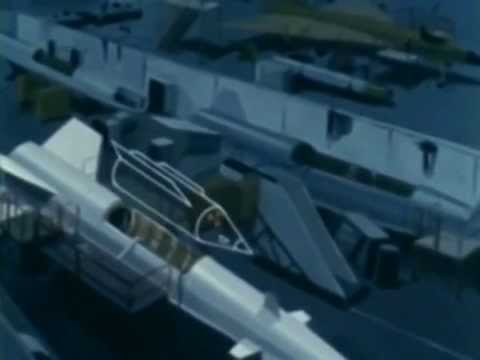Nuclear Ramjet (Project Pluto) to Drive “Big Stick” SLAM Missile circa 1959 USAF-Convair
more at
Late 50’s Convair proposal for “The Big Stick”, a Supersonic Low Altitude Missile (SLAM) driven by a nuclear reactor-powered ramjet. The missile could loiter in flight for long periods before dashing at Mach 3 to the targets, delivering multiple atomic bombs. It also would leave a stream of nuclear fallout from its reactor in its wake. SLAM development was cancelled in 1964.
Public domain film, slightly cropped to remove uneven edges, with the aspect ratio corrected, and mild video noise reduction applied.
The soundtrack was also processed with volume normalization, noise reduction, clipping reduction, and/or equalization (the resulting sound, though not perfect, is far less noisy than the original).
The Supersonic Low Altitude Missile or SLAM… was a canceled U.S. Air Force project conceived around 1955. Although it never proceeded beyond the initial design and testing phase before being declared obsolete, it represented several radical innovations as a Nuclear delivery system.
The SLAM was designed to complement the doctrine of mutually assured destruction… In the event of nuclear war it was intended to fly below the cover of enemy radar at supersonic speeds, and deliver thermonuclear warheads to roughly 16 targets.
The primary innovation was the engine of the aircraft, which was developed under the aegis of a separate project code-named Project Pluto, after the Roman god of the underworld. It was a ramjet that used nuclear fission to superheat incoming air instead of chemical fuel. Project Pluto produced two working prototypes of this engine, the Tory-IIA and the Tory-IIC, which were successfully tested in the Nevada desert. Special ceramics had to be developed to meet the stringent weight and tremendous heat tolerances demanded of the SLAM’s reactor. These were developed by the Coors Porcelain Company. The reactor itself was designed at the Lawrence Radiation Laboratory.
The use of a nuclear engine in the airframe promised to give the missile staggering and unprecedented low-altitude range, estimated to be roughly 113,000 miles (182,000 km) (over four and a half times the equatorial circumference of the earth). The engine also acted as a secondary weapon for the missile: direct neutron radiation from the virtually unshielded reactor would sicken, injure, and/or kill living things beneath the flight path; the stream of fallout left in its wake would poison enemy territory; and its strategically selected crash site would receive intense radioactive contamination. In addition, the sonic waves given off by its passage would damage ground installations.
Another revolutionary aspect of the SLAM was its reliance on automation. It would have the mission of a long-range bomber, but would be completely unmanned: accepting radioed commands up to its failsafe point, whereafter it would rely on a Terrain Contour Matching (TERCOM) radar system to navigate to preprogrammed targets.
Although a prototype of the airframe was never constructed, the SLAM was to be a wingless, fin-guided aircraft. Apart from the ventral ram-air intake it was very much in keeping with traditional missile design. Its estimated airspeed at thirty thousand feet was Mach 4.2.
The SLAM program was scrapped on July 1, 1964. By this time serious questions about its viability had been raised, such as how to test a device that would emit copious amounts of radioactive exhaust from its unshielded reactor core in flight, as well as its efficacy and cost. ICBMs promised swifter delivery to targets, and because of their speed (the Thor traveled at roughly Mach 12) and trajectory were considered virtually unstoppable. The SLAM was also being outpaced by advances in defensive ground radar, which threatened to render its stratagem of low-altitude evasion ineffective…
Project Pluto was a United States government program to develop nuclear powered ramjet engines for use in cruise missiles. Two experimental engines were tested at the United States Department of Energy Nevada Test Site (NTS) in 1961 and 1964…
History
On January 1, 1957, the U.S. Air Force and the U.S. Atomic Energy Commission selected the Lawrence Livermore National Laboratory’s (LLNL) predecessor, the Lawrence Radiation Laboratory, to study the feasibility of applying heat from nuclear reactors to ramjet engines. This research became known as “Project Pluto”. The work was directed by Dr. Ted Merkle, leader of the laboratory’s R-Division…
On May 14, 1961, the world’s first nuclear ramjet engine, “Tory-IIA”, mounted on a railroad car, roared to life for a few seconds. Three years later, “Tory-IIC” was run for five minutes at full power… On July 1, 1964, seven years and six months after it was started, “Project Pluto” was canceled…

